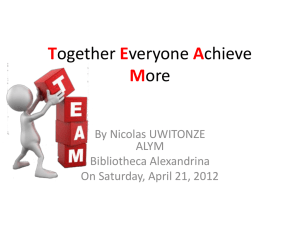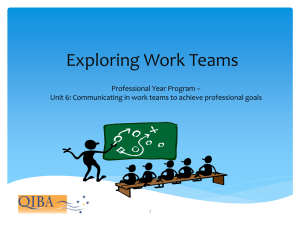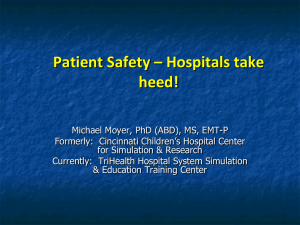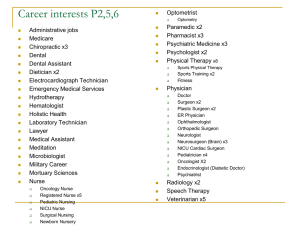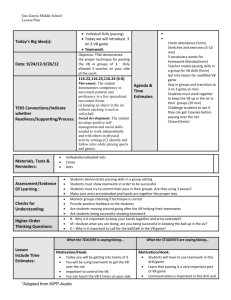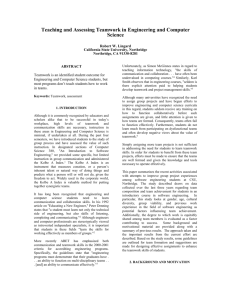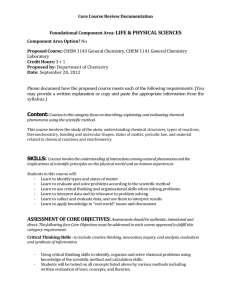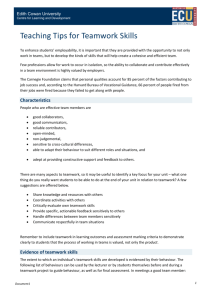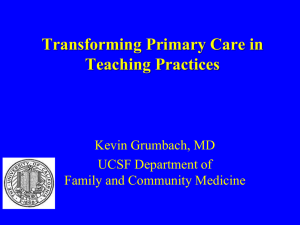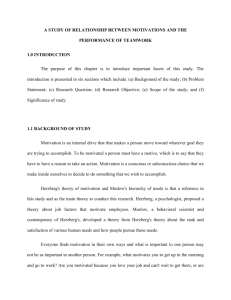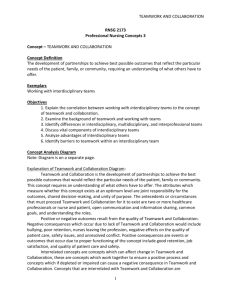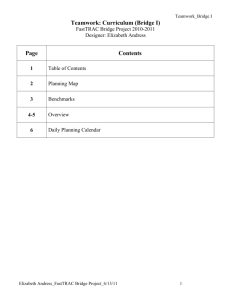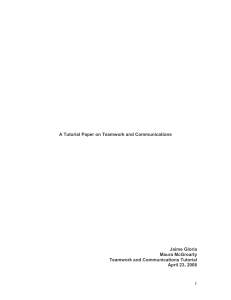PPT - Uniformed Services University of the Health Sciences
advertisement
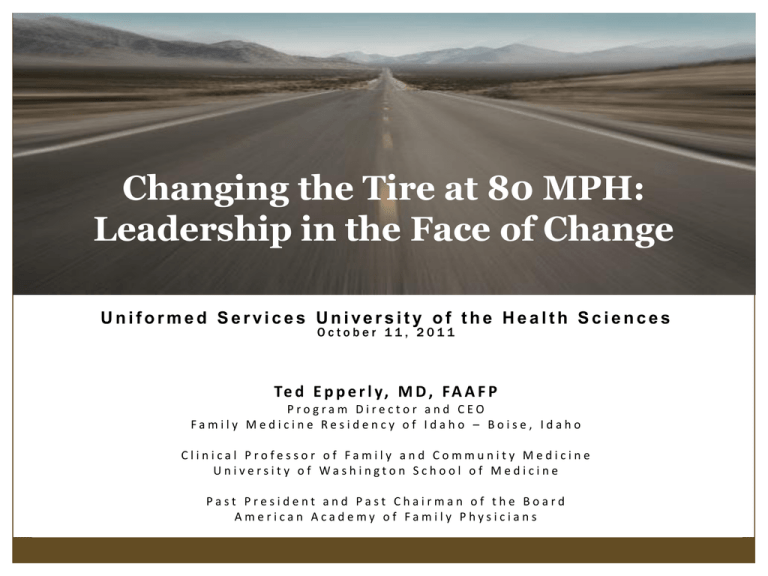
Changing the Tire at 80 MPH: Leadership in the Face of Change Uniformed Services University of the Health Sciences October 11, 2011 Te d E p p e r l y, M D , FA A F P Program Director and CEO Family Medicine Residency of Idaho – Boise, Idaho Clinical Professor of Family and Community Medicine University of Washington School of Medicine Past President and Past Chairman of the Board American Academy of Family Physicians Change Change is inevitable, difficult and messy. Success rates not impressive: Positive Change – 20% Partial Success or Outright Failure – 80% Eric Beaudan, “Making Change Last: How to Get Beyond Change Fatigue”. Ivey Business Journal, Jan/Feb 2006 Ingredients for Change Jacqueline S. Thousand & Richard A Villa: Managing Complex Change; 2001 Common Reasons Change Falters or Fails Weak case – low urgency, lack of a “burning platform”. Insufficient resources (time, materials, tools, training, leadership, $, attention). Not enough communication. Failure to anticipate and/or respond to factors or events that can derail change. Beliefs About Change Negative Assumptions: It doesn’t improve things. We never finish it. Resistance will always kill it. Managers can’t lead it. It ruins what we had which was always better. Why did it take 30 years to remove sails from steamships? Copyright Allen R. Wenner 2007 | May be reused if acknowledged Challenges So What Do You Do About Leading Change? Objectives By the end of this lecture the learner will: 1. Recite the four stages of change. 2. Describe the three important elements of leadership. 3. List at least five of the eight stages of creating major change. 4. Describe the leadership differences between buffalos and geese. Staff Reactions to Change 15% - Angry 40% - Fearful, Skeptical, and Distrustful 30% - Uncertain but Open 15% - Hopeful and Energized The Three Faces of Change Source: Ted Epperly, MD Four Stages of Change Foundational Elements in Leading Change Three Critical Success Factors: Leadership Teamwork Communication Two Styles of Leadership Source: Ted Epperly, MD Leadership Three Important Elements of Leadership 1. The ability to set a vision for an organization/team. 2. The ability to communicate that vision to the organization/team. 3. The ability to gather the resources necessary to help the organization or the team accomplish the vision/mission or objective. Dimensions of Change Conceptual/Cognitive Technical Structural Adaptive (human social) Reframe Change How one views change – be positive! How we think influences how we act. WHAT – HOW – WHY. Perspective and Approach = Confidence The Speed of Change People can successfully work with a lot of uncertainty and newness (change); however… Speed exceeds individual absorption of change: Fatigue Emotional Burnout Interpersonal Strife Inefficiency Resistance Illness Quitting (in place or out the door) Daryl R. Conner, Managing at the Speed of Change, Random House, 2006 Keeping Change Aloft Ups and downs. Keep change from stalling completely, losing momentum and stopping. Focus on a strong start of initiative. Leadership team leads by word and deed. Pace the change. Resolve to lead the change to the end. Deal with obstacles to change. Change Management Activities and Tools INITIATING CHANGE Case for Change, What’s In It For Us, ROI (Heart/Motivation; Head/Reason) Clear Destination Engage and Communicate FACILITATING, MANAGING AND LEADING CHANGE PDSA Cycles Critical Questions Engage and Communicate Be prepared for resistance and obstacles Recognition, Incentives/Rewards Bring in the customer: get ideas, feedback, perspective MONITORING AND MAINTAINING FORWARD MOTION OF CHANGE Relentless focus on RESULTS AND GOALS Review of what’s working, what’s not Anchor changes in organization Leadership Role of leadership team throughout a project: Develop a compelling and inspiring vision. Empower all staff to become active and creative members of the project. Oversee and monitor the integration and coordination of change. Publically celebrate milestones. Actively solicit honest feedback. Teamwork Tools and Resources Ground Rules: Senior Leadership Team Oversees - Integrates Communicate and Engage Not just about doing. About being present with the people. We generally don’t lack ideas about what. The challenge is how to orchestrate the process. Communication Develop process to deal with issues that arise. Use staff meetings to communicate progress and changes in timelines. Meet at least bi-weekly. Post relevant organization change information. Increasing the Speed of Change Communicate and Engage Support People in the Transition Engage the Resistance Provide Training in the New Skills Teamwork and Communication Basics Skills for New Roles and Functions It’s About the People “We work hard at the details of new processes or new technologies, but expect magic metamorphosis of the people expected to use those processes and technologies. We simply forget or ignore that organizations change when the people in them change.” Shapiro, CREATING CONTAGIOUS COMMITMENT, 2003 The People “I asked the manager how the change was going…His response, “its going fine - except for the people.” Shapiro, CREATING CONTAGIOUS COMMITMENT, 2003 The People “It is typical to approach change with strategic plans, supportive data, and structured timelines. All these steps are necessary, but they risk failing without: understanding that people are galvanized to change at the feeling level” The Message Choosing the right words [increases] the space…for new possibilities. Presenting the change as a way to deliver better patient care (patient centered care) makes it easier for staff to “feel good” about the change. Transition in Change Change is about the new. Transition is about the human psychological response to change Begins with an ending – a letting go of the old There is a time in the middle (aka, the neutral zone) – a time when old identity and old reality are gone, but the new ones have not yet taken root in your heart and mind Ends with a new beginning – new energy, sense of purpose, outlook, image of what is possible William Bridges, Managing Transitions and Getting Them Through the Wilderness: A Leader’s Guide to Transition The Change Lifecycle Effective Change The Second Curve Crossing the Desert What Leaders Can Do Keep communicating. Lead by walking around. Picture the destination. Acknowledge difficulties, keep leading forward. Give it the time it needs, but avoid a stall or loss of momentum. Cut off the old way but acknowledge it. Establish the new culture by anchoring it. Getting to the New Destination Engage Resistance All change runs into resistance. Be prepared to face open and low-lying resistance; it can come from unexpected sources (yourself included). People who support change in the beginning may move to resistance at some point in the process. It happens. Ignoring resistance will kill the change effort. Principles for Overcoming Resistance to Change It is natural and inevitable: Expect it It does not always show its face: Find it It has many motivations: Understand it When you meet it, deal with concerns rather than arguments: Confront it There is no one way to deal with it: Manage it Hammer, Michael and Steven A. Stanton, The Reengineering Revolution, Harper Business, 1995 Three Questions to Ask 1. What is changing? 2. What will actually be different because of the change? 3. Who’s going to lose what? What is Changing? Describe the change clearly and concisely. Tie it to solving a problem or seizing an opportunity. Communicate this frequently. What Will Actually Be Different? How will affect those who do the work? Vague and abstract to those it will affect – be clear! Describe what the differences will be; if they are not fully known now, let people know that – say what you know. Be honest; establish vulnerability and trust. Who’s Going to Lose What? Shift of the organization’s structure. More flat organization which changes the role and status of leaders, managers and staff alike. Can cause serious passive or open resistance in organizations. For leaders a two-fold challenge: manage your own reaction and help others manage theirs. Who’s Going to Lose What? The best way to get people through the transition is to affirm their experience and help them deal with it Listen Understand Bring issues out Give people tools Why the Three Questions Are Important Begin a process of essential communication. Create a climate of listening which reassures people and defuses opposition. Can generate information that you as a leader may not already know; this can help you as you lead the change to completion. Will help you since you are in transition too! Provide Training in the New Skills Opportunity to learn more. As leaders, facilitate and support the learning . We lead by what we say and what we do. Five Characteristics for High Performance Dysfunctions What Leaders Can Do Inattention to… Results Focus on collective results Avoidance of… Lack of… Accountability Confront difficult issues Commitment Fear of… Absence of… http://www.youtube.com/watch?v=lC7CFB6A1Doandfeature=related Conflict Trust Force clarity and closure Demand debate Be vulnerable “Like a chain with just one link broken if even a single dysfunction is allowed to flourish teamwork deteriorates, politics prevail, results suffer, progress stalls.” Final Thoughts on Change Unpredictable and unwieldy. Look out for obstacles, resistance, fatigue and other gnarly problems. Steer a course through turbulence. Revise plans when necessary Resolve to “go on to the end” and to succeed Be visible. Eight Stage Process of Change 7. Establish a sense of urgency. Create the guiding coalition. Develop a vision and strategy. Communicate the change vision. Empower brand-based action. Generate short-term wins. Consolidate gains and produce more change. 8. Anchor new approaches in culture. 1. 2. 3. 4. 5. 6. Source: John Kotter – Leading Change Sustainable Change Keep your change alive on all three levels: The individual. The small group/team. The entire practice system. The Larger System Team or Organization Self Small Changes can have a big impact Changes don’t occur in a linear fashion. Small changes can have dramatic effects. “In the long run the only sustainable competitive advantage is your organization’s ability to learn faster than the competition.” - Peter M. Senge, The Fifth Discipline, The Art and Practice of the Learning Organization, 2006 Integration Symphony of Care “Love is better than Anger. Hope is better than fear. Optimism is better than Despair. So let us be loving, hopeful and optimistic people.” - Jack Layton Questions
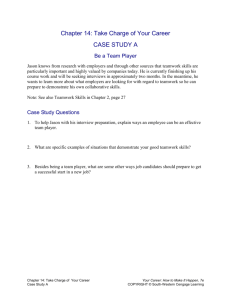

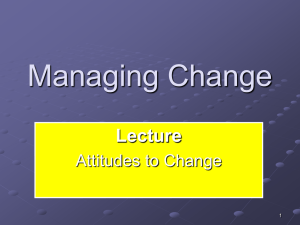
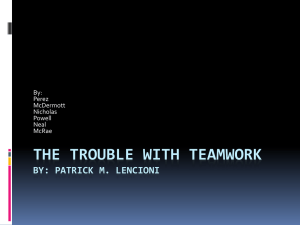
![Teamwork [doc]](http://s3.studylib.net/store/data/007119492_1-4f52bf0b0aa8b7482c84777d359de0b7-300x300.png)

